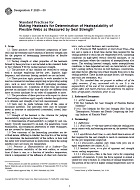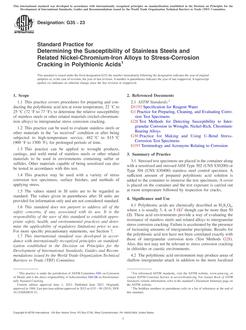
ASTM F2029-00
1.1 These practices cover laboratory preparation of heatseals and the treatment and evaluation of heatseal strength data for the purpose of determining heatsealability of flexible barrier materials.
1.2 Testing strength or other properties of the heatseals formed by these practices is not included in this standard. Refer to Test Methods F88 for testing heatseal strength.
1.3 The practices of this standard are restricted to sealing with a machine employing hot-bar jaws. Impulse, high-frequency, and ultrasonic heating methods are not included.
1.4 These practices apply primarily to webs intended to be used on commercial machines employing reciprocating sealing jaws, such as most vertical form-fill packaging machines, platen heatsealers, etc. Conditions of dwell time and sealing pressure on machines of this type typically are different from those on rotary machines by an order of magnitude or more.
1.5 The procedures of these practices with respect to choice of heatsealing conditions apply equally whether the application is to ultimate seal strength or hot tack measurement.
1.6 Seals may be made between webs of the same or dissimilar materials. The individual webs may be homogeneous in structure or multilayered (coextruded, coated, laminated, etc.).
1.7 Strength of the heatseal is the criterion for judging heatsealability employed in these practices.
1.8 Determination of heatsealability as judged by seal continuity, typically measured by air-leak, dye penetration, visual examination, microorganism penetration or other techniques, are not covered by these practices.
1.9 Two variations of the heatsealing procedure are described herein, differing in whether the objective of the testing is to determine, the heatsealability of the surface, or how well the entire web would heatseal in applications where the sealing interface may not reach jaw temperature.
1.9.1 Practice A, Heatsealability of a Surface-This method measures sealability of the web surface, or sealant layer if there is one, as a function of interface temperature, which is independent of the influence of other web characteristics, such as total thickness and construction.
1.9.2 Practice B, Web Sealability at Short Dwell Time-The test seal is made at a dwell time shorter than required for the sealing interface to reach the jaw temperature level, simulating conditions on high-speed vertical form-fill machines, or on slower machines where the condition of nonequilibrium also exists. The resulting heatseal strength, under nonequilibrium conditions, is then dependent not only on characteristics of the web’s sealing surface, but also on web thickness, construction, and other factors affecting rate of heat transfer from jaws to the sealing interface. These include machine factors; (for example, anti-stick jaw treatments, etc).
This standard does not purport to address all of the safety concerns, if any, associated with its use. It is the responsibility of the user of this standard to establish appropriate safety and health practices and determine the applicability of regulatory limitations prior to use.
Product Details
- Published:
- 05/10/2000
- Number of Pages:
- 9
- File Size:
- 1 file , 90 KB

